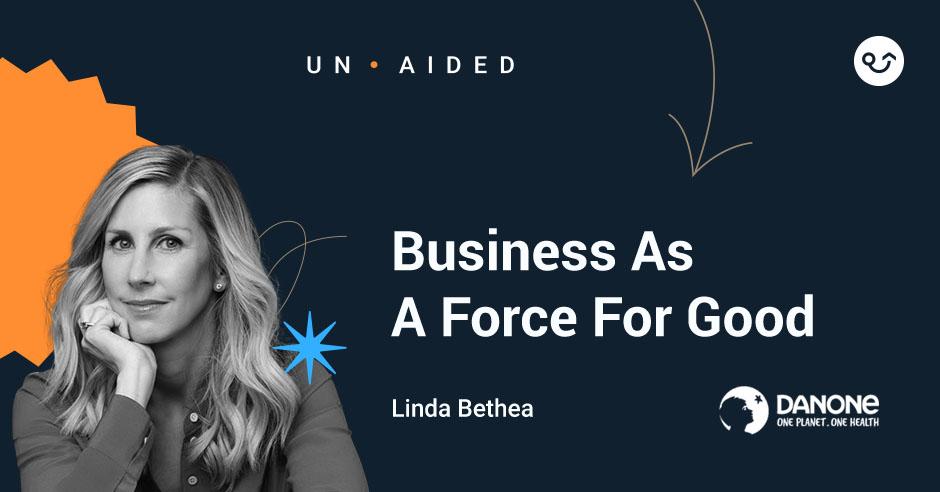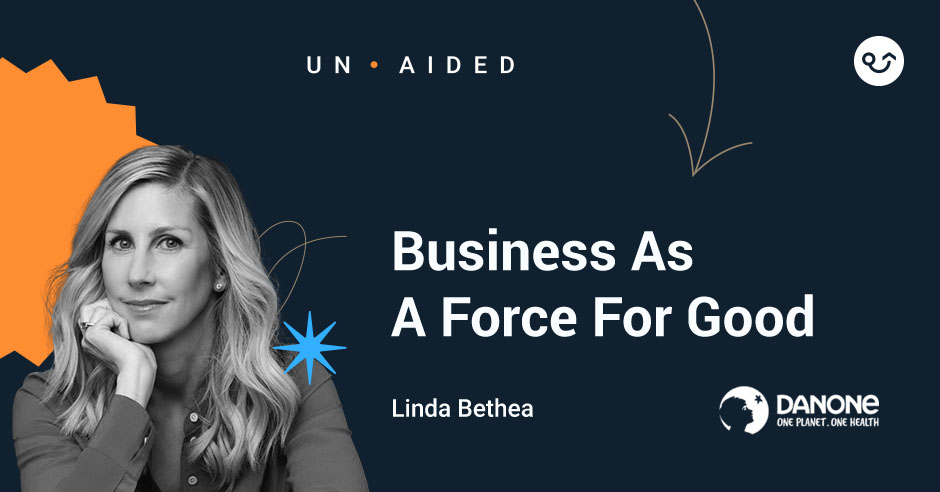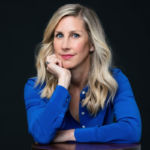
Business As A Force For Good With Linda Bethea Of Danone
Posted in:

It’s a balancing act to deliver against objectives, deliver profits to the community and think about the impact. But, when a business can set aside resources to make itself more profitable, it has the ability to make a long lasting impact. Evan Brandoff explores this with Linda Bethea, the Head of Marketing at Danone North America. She discusses how she’s helped iconic brands serve local communities and promote noble advocacies, all while keeping good revenue. Linda also dives deep into what doing business for good means and how to achieve that.
—
Watch the episode here
Listen to the podcast here
Business As A Force For Good With Linda Bethea Of Danone
In this episode, we welcome Linda Bethea onto the show. She is the Head of Marketing at Danone North America, where she leads a cross-functional team responsible for delivering best-in-class marketing plans across Danone’s 30-plus brands. Prior to Danone, Linda was Vice President of Marketing at Diageo, the world’s largest spirits company where she was responsible for turning around Captain Morgan, their flagship rum brand in North America. She began her career in marketing at PepsiCo where she spent eleven years in marketing, innovation, and sales roles across both Frito-Lay and Pepsi beverage companies. Let’s get into it.
—
Linda, welcome to the show.
How are you? Thanks for having me.
I am doing great. How are you doing?
I’m wonderful. Thank you.
I’ve got to say, Linda, I’m pretty sure that if you were to ask a CPG marketer or any marketer what their ideal career trajectory would be, I think it would be exactly yours.
I’ve been very lucky. I’ve had a very great career.
I’m so excited to dig into it but before we do, I’d love to go back in time to high school, Linda. Where are you from?
Are you sure you want to do that?
Yes, I would love to do that.
I am originally from Massachusetts. I went to an all-girls Catholic high school and had no idea I would end up where I did. If you had asked the high school Linda, who would she be sitting here now as the head of marketing at Danone, she would’ve thought you were crazy.
What was high school Linda like?
She was very academic. I loved reading and the teacher’s pet-type stuff. I was very involved in dance and drama. Those were my main activities in high school and very focused on going to a good college and starting my life.
You did go to an amazing college in Tufts. What did you study at Tufts?
I was an American Studies major, which meant that I had no idea what I wanted to do with my life. It was an interdisciplinary major where you could combine different classes into an interesting thesis. I took a class in my senior year on advertising and fell in love with marketing and advertising. That’s eventually what sparked my interest in going into this field.
That was going to be my next question. What sparked your interest going? It was class and undergrad. That’s amazing.
Tufts has a program called the Experimental College where any student or professor can propose a class topic, and somebody had proposed an advertising class, which was very interesting for a liberal arts school. I fell in love with the discipline, understanding consumer behavior, how people think, and what types of things resonate with them so I decided to pursue a career in marketing and advertising.
If you could go back to college, would you study American Studies again? Would you recommend to someone now going to school to study something potentially more in line with the career that they want to go into?
Personally, I would not do it differently. I think having an interdisciplinary major gave me a great foundation for what I do now. What I love so much about marketing is it’s different every single day. There are days that I’m evaluating creative and looking at advertising campaigns and working with my agencies on that side of the business. There are days that I’m knee-deep in Excel spreadsheets working on P&Ls or budgets, financial models, and things like that.
Marketing is different every single day.
There’s also a lot of leadership and collaboration and influence and all those skills are things you learn through different classes in finance, psychology, English, etc. I think I’ve got a good foundation in interdisciplinary studies and ultimately, I was able to go on to get my MBA and specialize more in business and marketing, which gave me the functional skills I needed. My undergrad helped prepare me more for leadership and working in big organizations.
Something that I personally enjoy about watching your career and success is I went to the University of Texas and Frito-Lay recruits heavily. My first job out of school was almost joining the marketing department at Frito-Lay, but I ended up going a different path. I’m curious. What did I miss out on? How was it starting your career at Frito-Lay?
It was a fantastic place to start a career other than the free chips, which was a great perk. It was a good training ground. Frito recruits from some of the top business schools around the country, and they’re known for a rigorous training program. When you start there post-MBA, you get a rotation across all of the major pieces of brand management. I started my career there as an associate brand manager at Lay’s potato chips, which is their flagship brand and one of the largest brands in the building.
I got to touch a lot of different things early in my career and learn how to run a business and all of the different pieces that go into that. From there, I moved over into an innovation role, which was completely different. We were looking at how to launch new brands in the premium snack space, so a lot of white space opportunities, working in ambiguity, starting from scratch, and flexing different muscles from a business and marketing standpoint.
I went back over to the brand side for my second tour of duty on Lay’s, which at that point was in a very different place from a competitive standpoint. It was a very different business challenge to deal with. I got some great experiences working on a big brand, a challenger brand, and all different types of things that made me a better marketer. It was great foundational knowledge from a Frito standpoint.
At that point, I realized that if I wanted to be a great leader, I needed to understand different parts of the business. Not only marketing, but I raised my hand and ask for a rotation into the field. You probably know Frito-Lay runs what’s called a direct store delivery system. They have tens of thousands of employees out in the field every day delivering their products directly to the store. It’s one of the things that give them that competitive advantage is having all of those employees’ feet on the street. I moved from Texas up to the Northeast and did a rotation in field sales, working for a strong leader in one of our most competitive markets, which was a fantastic experience for me.
Is that what brought you to New York at that point?
I moved up to New York with my daughter and 65-pound German Shepherd.
I might have the timeline slightly wrong, but my understanding is when you began working on the Lay’s brand, you alluded to it slightly. It wasn’t as prominent as it is now or it was prior. Is that accurate?
I think it was struggling with a lot of competitive pressures as well as societal pressures. Any big brand goes through life and loses prominence for various reasons. It’s your job as a marketer to ensure that you are trusted with brand stewardship for a big iconic brand like Lay’s, you have to understand its history and what made it iconic and timeless. However, it’s also your job to make sure you keep it timely and irrelevant for this day’s consumers.

Force For Good: Any big brand goes through life and loses prominence for various reasons. The marketer’s job is to make it timeless and relevant to current consumers.
What we found on Lay’s was everybody knew what Lay’s was. It was a very beloved known brand, but it was also very reviled at that time because it was the epitome and symbol of junk food. At that point in our country, people were becoming increasingly knowledgeable about health and wellness. They were thinking that fat and salt were the enemy, and Lay’s became the poster child for junk food, which led to an erosion of sales.
There was also a proliferation of private labels at the time, so you could get in some people’s minds, the same potato chip for half the price. We were facing a number of different pressures on the business that marketers had to dig deep to determine how do we make this beloved iconic brand relevant again to consumers and drive the value that we believed we possessed.
Recapping the two competitive pressures was pricing pressure from competitors for the unhealthy version of the chip, or going a different route and being timely, as you eloquently said. How did you decide which route to go or where to start?
We did both. With a brand that big, I think you need to address full issues in order to drive significant growth. From a junk food standpoint, we decided to tackle that problem head-on and do some myth-busting. A lot of people thought that Lay’s was junk food, but if you turn over a bag of Lay’s classic potato chips, it’s only made with three simple ingredients, potatoes, oil, and salt. There’s nothing you can’t pronounce on that label. It’s a very simple product.
We created an entire campaign called Simple Ingredients that was educating consumers about the fact that Lay’s is made with three simple ingredients. We took it one step further to try to also drive value for the brand. Why should somebody buy our potato chips versus a private-label potato chip that would be half the price? What additional value are we offering to them? That’s a big thing within marketing what’s your value equation?
At the time, people were also becoming very interested in their local communities and making sure that they understood the foods and the brands that they were buying. Again, Frito-Lay is a huge company. Lay’s is a big brand, and big brands at that time had negative perceptions in the US. We also took our three Simple Ingredients campaign one step further and helped people understand that the simple ingredients we were using, the potatoes were grown by potato farmers in their local community.
We created an entire campaign that highlighted the individual potato farmers in their communities. In Texas, we had a campaign featuring Jack Wallace, one of our local Texas potato growers, talking about how long he’d been a farmer for Lays, the joy he got out of waking up every day and walking through his potato fields at dawn. In California, we ran a different campaign featuring Brian, who was a local potato farmer in California. In Maine, we had a completely different campaign. It was bringing the local nature of what we were doing at Lay’s to consumers around the world. That campaign helped us propel the growth of Lay’s to double digits, and we were the fastest-growing brand in CPG that time.
Congratulations.
Thank you. It was a great success story.
When did you get your nickname, the Velvet Hammer?
It’s a great nickname. That came after I’d moved up to New York and transitioned over to the beverage side of the business. PepsiCo owns Frito-Lay, their snack business based in Plano, Texas, and their beverage business based in New York. The beverage side of the business operates differently from a business standpoint in the sense that they have a number of bottlers that are the ones manufacturing and selling the products.
As a marketer, your job isn’t to tap into consumer needs, trends, and insights, and build these great campaigns. You also have to sell those into the bottling community and get them to want to invest in your products and your campaigns. It is a very interesting relationship and the power dynamic between corporate and the bottling system. A lot of these bottlers are family-run businesses that have been passed down from generation to generation.
They have a lot of experience and knowledge and don’t always believe in what the marketing team is telling them. You have to be very hands-on and very direct with them, but in a way that’s going to get them to see your point of view. I had to learn very quickly how to be persuasive in a very direct way, but also with a gentle touch. That was the time that I got the nickname the Velvet Hammer because I was able to do it the right way, but get done what we needed to get done.

Force For Good: Many bottlers are family-run businesses that have been passed down from generation to generation. They don’t always believe in what the marketing team is telling them.
Who originally gave you that nickname?
I think it was a leader at the time, and it stuck with me because when I left PepsiCo and moved on to my next role at Diageo, I didn’t realize that had stuck with my new boss, the CMO of Diageo at the time. That is how he introduced me to the new organization as the Velvet Hammer.
Let’s be honest, you added it to your resume, didn’t you?
I also have it tattooed on my arm.
What I find incredible, and we haven’t even gotten Danone yet, is the fact that you’ve both taken iconic brands like Lay’s potato chips and also Captain Morgan, and helped revitalize them. Simultaneously, you also helped launch new brands like Bubly, for example, which we love.
It’s one of my favorite brands to this day.
What gives you more energy? Taking a historic brand and revitalizing it or bringing a new brand to market?
It’s both. That’s why I love marketing because every day is something different. The challenge on Lay’s was a difficult challenge. There were so many late nights, and weekends partnering with my team, banging our heads against the walls, and figuring out how we were going to overcome some of the headwinds. When we ultimately did, and we were the fastest-growing CPG brand of the year, it was an extremely rewarding experience.
On the flip side, starting something from scratch, seeing either an unmet consumer need that you believe you can fulfill or a need that’s not necessarily being met as well as it could be by the competition is an exciting place to be. Also, creating something from scratch, coming up with the name, the visual identity, the packaging design, and the product itself is a fun process to be part of.
At a company as large as PepsiCo, there are several major players in the sparkling water space. Why build a new brand like Bubly versus buy a brand that has a strong reputation in the market?
It’s a great question, and it’s something that we look at all the time. Do you acquire versus create and different reasons do you go in different directions? More and more, big companies are struggling with creating something from scratch. It’s a very different muscle to exercise as an organization, and you need to have a lot of patience to start something from scratch because it’s not going to be an overnight success. You’re not going to create a $100 million business in year one, and big companies expect big results.
Luckily at the time at PepsiCo, we did have more appetite for launching smaller things in crowded competitive categories. We also believed we had the right marketing muscle behind us. Consumers don’t only buy products, they buy brands. The brands at the time in the sparkling water category weren’t big iconic brands. It was a lot of little cats and dogs.
It was a category that was exploding in growth at the time. Again, with continued health and wellness trends in the US, the sale of carbonated soft drinks was on the decline, the sale of bottled water was increasing exponentially, and flavored carbonated water combined the best of both worlds. We saw this as a huge business opportunity for us and one that we thought we could make a huge splash in. Bubly was born out of a business opportunity, and we think we absolutely nailed it with the branding, the packaging, and the product itself.
Our fridge is stacked with Bubly right now. Thank you. How far before a brand hits the shelves, is the ideation starting?
It’s a very long innovation cycle. You’re always starting by looking at the consumer landscape, trying to identify consumer trends and unmet needs but then you also need to match those with your business needs and opportunities. There’s a lot of strategic work that goes into something before you charter an innovation project and decide to embark on that.
What enticed you to join Danone a few years ago?
After 11 years at PepsiCo and 3 years at Diageo, I was ready for a new opportunity. I’d had the great fortune of working on salty snacks, soft drinks, and alcohol, all of which are very fun businesses but I was looking for something a little bit more. You reached a certain point in your life and you want to do something with more purpose. Many people don’t know this, but Danone is one of the largest certified B-corporations in the world.
What that means is that we’re committed to using business as a force for good. Companies talk about that, and it’s just that talk. Danone practices that every day. 2022 is the anniversary of the creation of what we call our Dual Project, which happened when our then-CEO came up with this trailblazing concept of putting profits and purpose together. It’s that’s not looking to do good in a business sense.
We’re absolutely committed to delivering against our objectives and delivering profits to the community, but we believe it’s equally important to think about the impact we’re having on that community. That then led to the creation of Danone’s purpose around one planet, one health. We want to deliver health through food to as many people as possible. That’s our mission here at Danone, and in doing so, we want to make sure that we’re not decimating the planet or having a positive impact through what we’re doing. That’s ultimately what attracted me here because I get to be part of that mission every single day.
Something else that I admire about you is I know you’re a big proponent of empowering women.
That is my personal mission in life. I’m a single mom, and every day that’s why I get up, go to work, and try to do my best to be a good role model for her and for others.
What role can a corporation play in supporting and empowering any group of people in society?
I think it can be tackled in a number of different ways. One, as an organization, you have to be committed to hiring and retaining female leaders, and that’s something Danone absolutely invests in. We’re very transparent throughout our hiring processes. If you look at our leadership teams, we have a significant number of women in leadership roles and not only traditionally female leadership roles.
Our head of sales is a woman, so we’re very committed to equal opportunity talent across the board and nurturing and developing that talent. We also, as a big company, believe we can have an impact on the world. Again, as part of our purpose as Danone. We have a number of programs focused on helping others do that as well. One of our big brands within the yogurt category is Light + Fit and its individual brand purpose is around economic empowerment for women.
We have a partnership with Dress for Success, which is a longstanding organization dedicated to helping women get into the workforce. We’ve partnered with them as well as created something we call our returnship program. As everybody knows, a lot of women take time off when they have children and find it difficult to go back into the workplace. We make that easier for them and we sponsor a number of different returnships here at Danone, specifically for women looking to get back into the workplace. What we found is once they have that first foot in the door somewhere and have rebuilt their resume, it’s a lot easier for them to move on in their career and get jobs elsewhere. We’re helping them do that at an accelerated rate.
My mother-in-law volunteers for Dress for Success and gets so much reward from doing it.
It’s a great organization and we’re very proud to be partnering with them.
Can you give us a sneak peek at some trends that you’re seeing? A sneak peek of new products that we might see launched in the next couple of years?
One of the biggest trends we’ve seen coming out of COVID as people have returned to the office and returned to school and work, etc. is more on-the-go consumption. We have a pretty broad portfolio of products, but we’re always looking at ways that we can make our products more accessible to consumers so that they can enjoy them in more places.
You’ll start to see us think more, not only of product innovation but packaging innovation as well, in order to make our products available to you any time of the day and anywhere you would like to enjoy them. I think another big trend we’re seeing is the continued interest in health and wellness coming out of COVID. It was a big wake-up call for a lot of people, and they started examining the impact of what they put in their bodies on their actual health.
There’s been a huge surge and interest in prebiotics and probiotics. Our Activia® yogurt line has long been aligned and associated with probiotics, and we’re going to continue to expand on that. We’ve launched a drinkable form of Activia® called Activia+ that has both pre and probiotics to help with all of those things. You’re also seeing a huge shift in consumption to plant-based diets or interest in a more flexitarian lifestyle because that has a dual benefit of being better for your health and better for the planet. We have a significant expansion and focus on our Silk® plant-based portfolio as well as our So Delicious Dairy Free portfolio.
In our household, I don’t think a day goes by that we’re not consuming So Delicious and Activia®. Thank you for bringing us healthy, delicious brands and I look forward to the innovations.
That’s truly what we believe in. You shouldn’t have to compromise taste for health, and that’s truly part of our mission is making sure as we’re delivering healthier food options, they taste as delicious as anything else available out there now.
Never compromise taste for health.
I’m excited to see the on-the-go options that the new packaging that you all come up with. It’s upsetting to me that yogurt in a tube is thought of as a kid’s product. “I want yogurt in the tube.” Hopefully, you can help us reposition or maybe you’re coming out with something even more convenient than that. Linda, this has been amazing. Before I let you go, we have a two-minute lightning round. There are three questions and two minutes to answer all of them. It’s the first thing that comes to mind. The first question is, what is a brand whose marketing you admire most?
I’m going to go back to my Boston roots and say Dunkin’ Donuts. Similar to the conversation we had on Lay’s, they’ve done a good job of evolving a big iconic brand into something more timely and relevant by dropping donuts and expanding into other parts of the business. America runs on Dunkin’ as an iconic campaign. I’ve admired what they’ve done over the years.
I’m curious, which Danone brand?
What do I admire the most? It’s like asking to choose between your children. I love them all.
You set yourself up for this.
I will say I love what we’ve done on International Delight, which a lot of people don’t know that we own. It’s one of the largest coffee creamer brands in the country, and we’ve had a lot of fun with that brand. We’ve done a lot of interesting partnerships and limited-time offerings for seasonal. We have a Grinch coffee creamer out right now for the holidays. If you haven’t tried that yet, it’s a great way to add some holiday cheer to your morning coffee but we’re going to start to do a lot of fun things with that brand on TikTok and in other places.
When you were a kid, what did you want to be when you grew up?
I wanted to be a teacher. I loved reading and school. In my job now, I am teaching in a lot of ways. I run a team of 87 people, and it’s my job to learn from them, but also teach them based on my experience. In some ways, I feel like I have achieved my childhood dream.
You also teach marketing courses occasionally too, right?
I do. I am an adjunct professor in Social Media Marketing. It’s a great way to stay connected to the community and up-and-coming talent and give back to the world.
Finally, what is your favorite youth sports memory?
I was a dancer growing up. I didn’t necessarily play youth team sports, but I was a dancer my entire life all through college, and I have so many memories of awful costumes. My mom tried to wrangle my hair into a bun for recitals and things like that, but overall, it was a great experience and lots of fond memories.
Linda, you are so smart, thoughtful, and inspirational to many marketers out there. Thank you so much for coming to the show.
Thank you for having me. I enjoyed it.
—
As a recap, we discussed the thought and effort that goes into turning around iconic brands, how to bring new brands to market, and how corporations can do well while doing good. Thank you for tuning in. See you next time, everyone. Play on.
Important Links
About Linda Bethea
 Linda Bethea is currently the Head of Marketing for Danone North America. In this role, she leads a cross-functional team responsible for delivering best-in-class marketing plans across Danone’s 30+ brands, including Silk, International Delight, Activia, Light & Fit, and Oikos.
Linda Bethea is currently the Head of Marketing for Danone North America. In this role, she leads a cross-functional team responsible for delivering best-in-class marketing plans across Danone’s 30+ brands, including Silk, International Delight, Activia, Light & Fit, and Oikos.
Prior to this role, Linda was Vice President of Marketing at Diageo, the world’s largest spirits company, where she was responsible for turning around Captain Morgan, their flagship rum brand in North America. Linda began her marketing career at PepsiCo, where she spent 11 years in marketing, innovation, and sales roles across both Frito-Lay and Pepsi Beverages Company. Key highlights include turning around the Lay’s potato chip brand, managing the $4B iced tea portfolio, and expanding the Aquafina water portfolio into new spaces through the launch of LifeWtr premium water and bubly sparking water.
Linda earned her BA from Tufts University and her MBA from the Kellogg School of Management. She lives in Pelham with her 12 year-old daughter, Finley.
